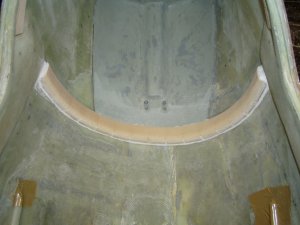Improved Fuselage
To increase the crash safety of our Std. Cirrus we have added to additional formers and two additional stringers. The idea behind: in case of a crash - primary when rolling against an obstacle or in case of a moderate steep ground impact a circular former behind the pedals increases the stiffness of the fuselage and prevents a premature buckling or degrade of the front canopy frame. Coevally this circular former leads the forces in case of a crash in the two additional stringers - left and right of the cockpit against the steel frame, which holds the shear force of the wings. This increases the survival cell of the pilot considerable. Further on the rearmost former (at the rear end of the canopy frame) stiffens the fuselage in this area and reduces the risk of buckling. The fuselage in front of the foremost circular former is used as a crash cell, which fails at lower forces and thereby takes over the energy of a crash.
More security features can be found at Crash Safety.
Foam as basis for the reinforcement of the canopy frame - here from the left side, in front of the steel-frame. The channel is for the air brake rod required.
The same on the right side.
In front the circular former (completely revolving) forms the closing.
The rearmost canopy frame former - here in building shell status.
On the right side the foam has to be omitted for the canopy release mechanism.
The left stringer after putting the fibre on the surface. Thereby the same build-up of the order of the layers as for the fuselage is used to assure a symmetrical force distribution between stringer and fuselage and therewith to prevent a premature buckle of the stringer ...
Both stringers and the front side former. The new finished steering-former can be clearly seen.
Transition between stringer and former on the rearmost canopy frame...
... the same on the other side.










